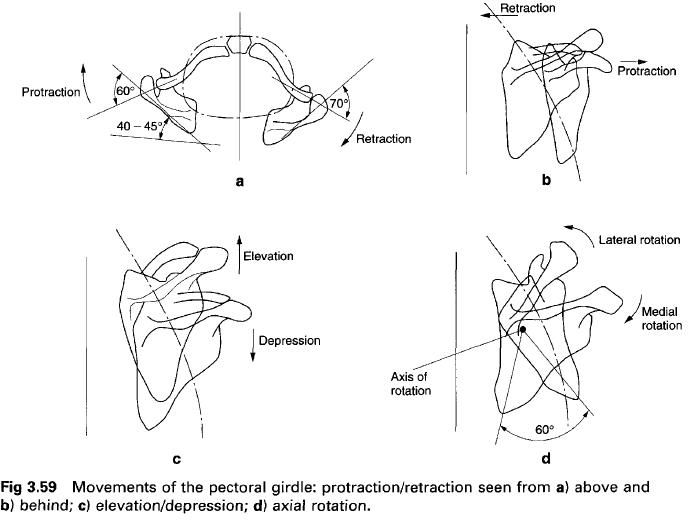Movements of the pectoral girdle serve to
increase the range of movement of the shoulder joint, principally by changing
the relative position of the glenoid fossa with respect to the chest wall. In
all of these movements the clavicle,
acting as a strut, holds the shoulder away from the trunk thereby securing
greater freedom of movement of the upper limb. It should be remembered that
movements of the pectoral girdle accompany virtually all movements of the
shoulder joint.
In movements of the pectoral girdle, the
glenoid fossa travels in an arc of a circle whose radius is the clavicle, while the medial border of the
scapula, held against the chest wall,
travels in a curve of shorter radius.
Consequently, the relative positions of clavicle
and shoulder blade must be capable of changing. This occurs at the
acromioclavicular joint. It now becomes obvious that a rigid union between clavicle and shoulder blade would
severely limit the mobility of the upper limb.
Lateral movement of the shoulder blade around
the chest wall brings it to lie more in a sagittal plane so that the glenoid
fossa faces more directly forwards(a,b). Medial movement towards the vertebral
column brings the shoulder blade to lie more in the frontal plane, with the
glenoid fossa facing more directly laterally. These two extreme positions of
the scapula form a solid angle of 40°
to 45°(a). Furthermore, the angle between the clavicle and shoulder blade decreases to approximately 60° on full
lateral movement of the shoulder blade, and increases to approximately 70° on
full medial movement(a). The total range of linear translation of the shoulder
blade around the chest wall is about 15cm.
Elevation and depression of the shoulder blade
has a linear range of some 10 to 12cm(c). However, it is usually accompanied by
some degree of rotation, so that in elevation the glenoid fossa comes to face
increasingly upwards. In depression, the
fossa points increasingly downwards. The rotation of the shoulder blade that occurs
with respect to the chest wall does so about an axis perpendicular to the plane
of the scapula, and is situated a
little below the spine close to the superolateral angle. The total range of
angular rotation of the scapula
amounts to 60°(d). This involves a displacement of the inferior angle of the scapula of 10 to 12cm, and that of the
superolateral angle of 5 to 6cm.
During abduction or flexion of the arm, the clavicle rotates about its long axis so
that its anterior surface is increasingly directed upwards. Towards the end of
the range of rotation of the scapula
against the clavicle, the
coracoclavicular ligament becomes taut and transmits the rotating force to the clavicle, whose rotation then accounts
for the scapular rotation on the chest wall. Any impairment of the clavicle to rotate at either the
sternoclavicular or the acromioclavicular joints will interfere with the free
movement of the shoulder blade and upper limb as a whole.
Although movements of medial and lateral
translation of the scapula, elevation
and depression, and its rotation with respect to the chest wall have been
discussed, it is important to remember that they do not occur as pure
movements. All movements of the pectoral girdle will involve some degree of
each of the above pure movements.
Biomechanics
Stresses
on the clavicle
The clavicle is subjected to both compression
and tension stresses, which under normal conditions are absorbed within it.
They only become apparent when the integrity of the pectoral girdle is
compromised, as by fracture, dislocation or muscular imbalance. Unlike the
pelvic girdle, because the pectoral girdle is not a complete bony ring, the
intrinsic stresses require the cooperation of muscles attached to it for there
to be equilibrium.
A compressive stress along the length of the clavicle directed towards the
sternoclavicular joint is produced by the action of trapezius and pectoralisminor as they pull the clavicle
towards the sternum. Forces transmitted medially from the upper limb to the
glenoid fossa are transmitted from the
scapula to the clavicle by
trapezoid ligament, and from the clavicle
to the first rib by the costoclavicular ligament. Consequently, falling on an
outstretched hand or elbow puts no
strain on either end of the clavicle at the joints. If the clavicle
fractures as a result, it does so between these two ligaments. In such
fractures, the two fragments tend to over-ride one another. These compressive
stresses are increased by lying on one shoulder.
Tension stresses within the clavicle are produced, under the action
of deltoid, when the upper limb is
abducted. Hanging and swinging forwards by the arms increases these tension
stresses. If sufficiently large they may lead to some discontinuity of the
pectoral girdle; however, a joint dislocation
is much more likely to occur than a fracture.
A rotational force transmitted through the scapula to the clavicle tends to damage the acromioclavicular and/or
sternoclavicular joints and their associated ligaments rather than causing a
fracture of the bone. Downward forces applied to the lateral end of the clavicle create bending stresses within
it, which, if sufficiently large or if the clavicle
comes into contact with the coracoid process, may lead to fracture of the bone.










0 коментара:
Постави коментар